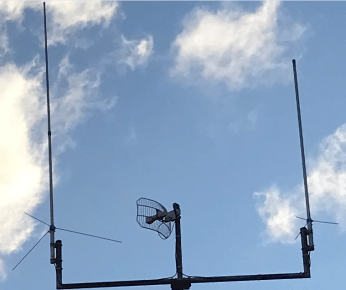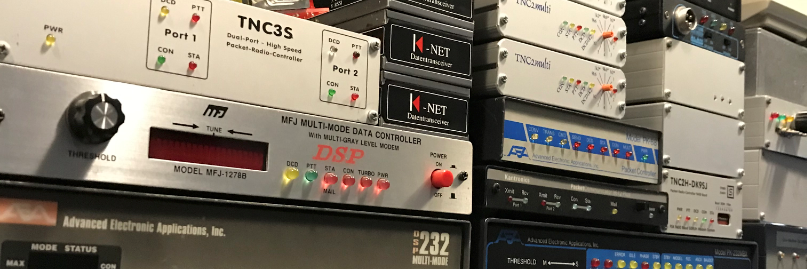Today I made a comparison between Direwolf and a KPC9612. Now I have to say that it is difficult to compare. As the first set I use a KPC9612 and a Yaesu 7900 with an x30 as antenna and as software PinPoint Aprs Client for Windows. As the second set I use a Realistic pro 2006 scanner with an x50 as antenna and Direwolf. These antennas are at the same height.

Now I am very impressed with Direwolf, it seems that my KPC9612 is completely deaf. I clearly hear the packet signal but there is no decode. Unfortunately I don’t have two the same sets and two the same antennas to make the comparison better. But it is very clear here that Direwolf wins big.
Below you can see the difference between the setups. The Communication monitor is from PinPoint Aprs Client, the rest is from direwolf and some aprs parsing.
Okay, I know the comparison isn’t entirely fair. But for me Direwolf is the big winner.


It might be interesting to leave the gear the same except swap the Kantronics for the Direwolf and see what happens over the next hour.
Did you make sure to get the Kantronics the proper receive levels?
Was this at 1200 baud or 9600? 1200 I suspect because you said you were using a scanner for one of the receivers?
It’d be really interesting if you could do the same series of tests with other TNCs, KPC-3, MFJ1270B, TNC-X
I’d send you a NinoTNC if you would be interested but I’d really like to see your test methodology expanded and explored. I don’t know that the KPC9612 is anywhere near as good as Direwolf, but you really didn’t get much into what happens under different circumstances. What if the other station was full quieting and sending long messages, vs weak and sending long vs short, and what happens with or without collisions? Direwolf has a superior ability to decode packets that started right in the middle of a weaker packet, i think. That is one place a firmware TNC is going to really suffer compared to Direwolf. But what if that never happened? Was Direwolf still superior?
What about the other TNCs vs the KPC9612. I have a hard time believing the KPC9612 is worse than an MFJ1270B, for instance.
These are interesting questions that would be nice to resolve in your test scheme.
And then there is 9600 baud.
And then there is how little time in the universe to solve these problems. Keep up the good work!
— KA2DEW
>It might be interesting to leave the gear the same except swap the Kantronics for the Direwolf and see what happens over the next hour.
Hi Tadd. Thank you for your answer, I really appreciate that. I will definitely do another test, I will swap the kpc with direwolf.
>Did you make sure to get the Kantronics the proper receive levels?
I don’t have an scope, I did this based on hearing and most decoded packets.
You break the test down to the bottom. And you are absolutely right. The Test is far from fair.
>Was this at 1200 baud or 9600? 1200 I suspect because you said you were using a scanner for one of the receivers?
>It’d be really interesting if you could do the same series of tests with other TNCs, KPC-3, MFJ1270B, TNC-X
Yes it`s 1200 baud, I can swap it with a MFJ 1278B, Tnc3s, aea 2232 DSP, etc
>I’d send you a NinoTNC if you would be interested but I’d really like to see your test methodology expanded and explored. I don’t know that the KPC9612 is >anywhere near as good as Direwolf, but you really didn’t get much into what happens under different circumstances. What if the other station was full quieting >and sending long messages, vs weak and sending long vs short, and what happens with or without collisions? Direwolf has a superior ability to decode packets >that started right in the middle of a weaker packet, i think. That is one place a firmware TNC is going to really suffer compared to Direwolf. But what if that >never happened? Was Direwolf still superior?
Yes that will always be the question.
A friend of mine also responded to it. Here are his reaction …
Might be a problem with the KPC9612 too if it’s completely deaf. Some time ago I also noticed some of my TNCs were deaf after more than 20 years doing nothing but laying in a closet… Until I placed some fresh crystal oscillators (some were completely off)’, did a recap, and realigned stuff where/when possible. Made a big difference!
Direwolf still outperforms all hardware TNCs I own. Some with a big difference, and some with a very small difference. Did some testing too about a year ago, but with equal test conditions and the test CD mentioned in Direwolf’s docs.
>What about the other TNCs vs the KPC9612. I have a hard time believing the KPC9612 is worse than an MFJ1270B, for instance.
>These are interesting questions that would be nice to resolve in your test scheme.
>And then there is 9600 baud.
Tadd, you gave me more than a day job. Very nice. Thank you for thinking along.
>And then there is how little time in the universe to solve these problems. Keep up the good work!
>— KA2DEW
73 Niels PD9Q
In aprs test Direwolf outperformed most other systems. My question for forward correction on 9600baud is it different than the new TARPN TNC board. I hope not since I am building a direwolf system and I want to run 9600 Baud.
Tim, Direwolf implements FX.25 which is backward compatible with AX.25. FX.25 does this compatibility by sending the full AX.25 packet with additional material to perform the error correction. This means an old TNC can still decode the packet. It also means the FX.25 packet is bigger than the AX.25 packet.
NinoTNC uses IL2P which is NOT backward compatible with AX.25. It removes some inefficiencies of AX.25 to make the packets smaller and then adds in extra material to do the forward error correction. IL2P packets are sometimes smaller than AX.25 and sometimes larger. Shorter packets are smaller than AX.25. The added material amounts to around 10% added length and once the packet gets to be 40 bytes of data the packet grows to bigger than a 40byte-data AX.25 packet.
So there is some good news and some bad news about each of the Forward Error Correction methods. But they are not compatible.
The NinoTNC engineers believe that IL2P will be popular with people building two-ended backbone links. The TARPN project is all about building two-ended backbone links because they are (between 10x and 1000x) faster (when saturated) than multi-station packet channels. So the TARPN project will be very happy with IL2P and the TAPRN NinoTNC.
There are several factors to consider when trying to make a fair comparison. First, you would want to use the audio from the same receiver fed into multiple TNCs at the same time and count how many frames each decoded properly.
Some demodulators are fussier about the relative amplitude of the two 1200 bps AFSK tones and don’t work so well if there is a substantial imbalance. This can occur due to pre-emphasis in the transmitter and/or de-emphasis in the receiver. You might get considerably different results if you use audio from the speaker or before the audio filtering stage.
Audio level can also make a big difference. In one of my tests I found that the decoding performance of a popular TNC was very dependent upon the audio input level. There was no convenient way to tell if the audio level was in the good performance range or not.
You can find more of my rambling, on this subject, here:
https://github.com/wb2osz/direwolf/blob/dev/doc/A-Better-APRS-Packet-Demodulator-Part-1-1200-baud.pdf
https://github.com/wb2osz/direwolf/blob/dev/doc/WA8LMF-TNC-Test-CD-Results.pdf
9600 bps is an entirely different beast. You can’t use the microphone and speaker connections because the audio stages distort the signal too much. Many transceivers have a connector that bypasses the normal audio processing and allows a fairly flat bandwidth out to 5 kHz.
More 9600 bps information:
https://github.com/wb2osz/direwolf/blob/dev/doc/A-Better-APRS-Packet-Demodulator-Part-2-9600-baud.pdf
Hoi John, thanks for the information. I`m running some tests now with the same audio into Direwolf and a Symek Tnc3s. The Tnc3s preforms very well, I can’t see any difference with my naked eye. I’m thinking of using kissutil for this 1 on direwolf and 1 on the tnc3s, then I will have each frame stored in a directory. Then I can at least compare the received frames. The numbers.